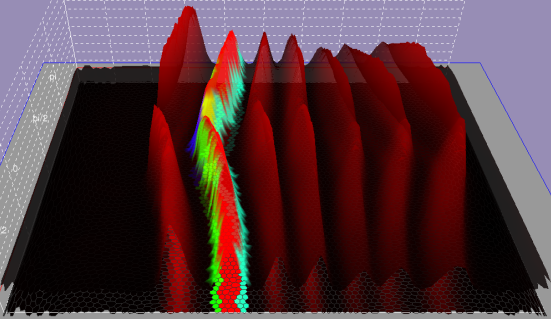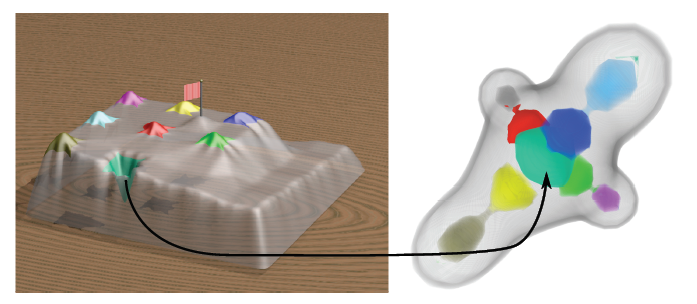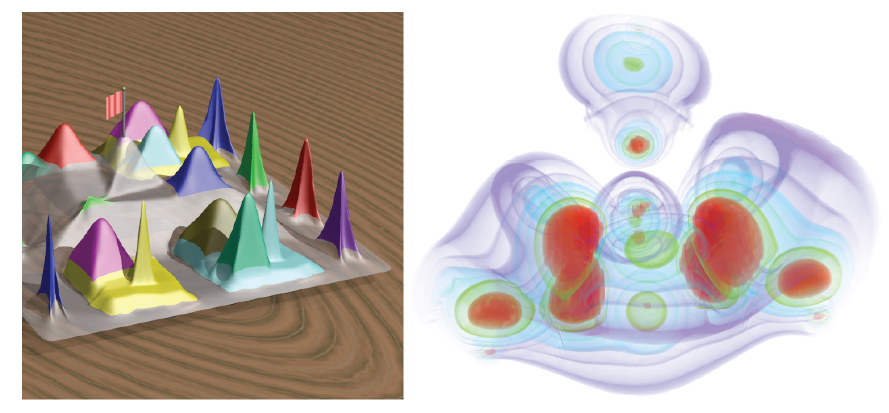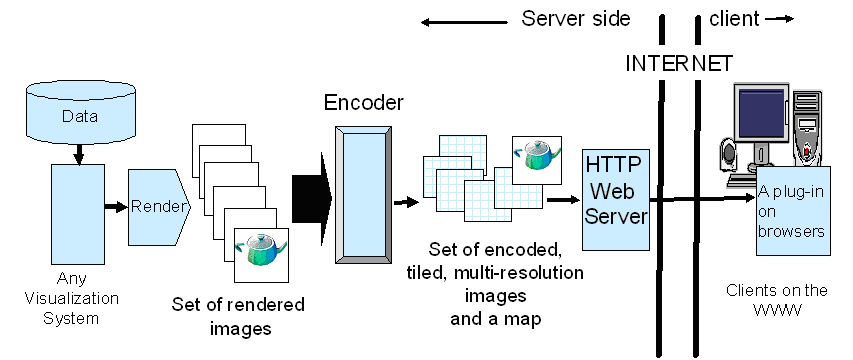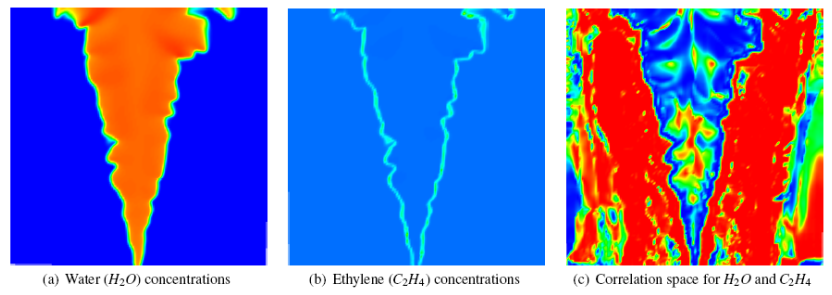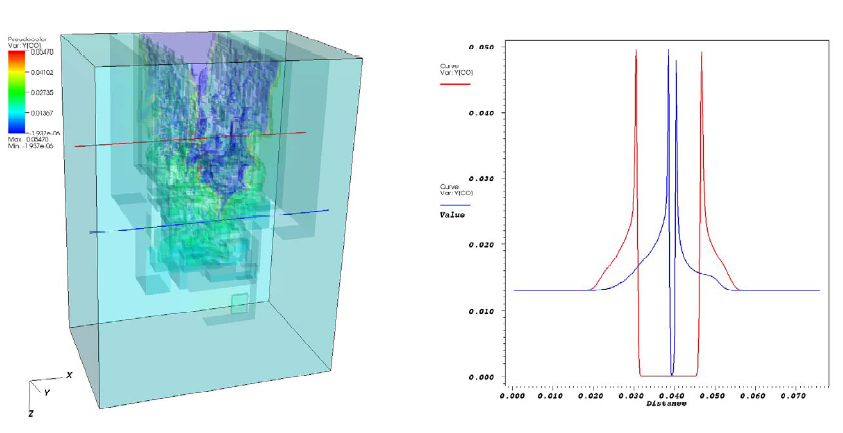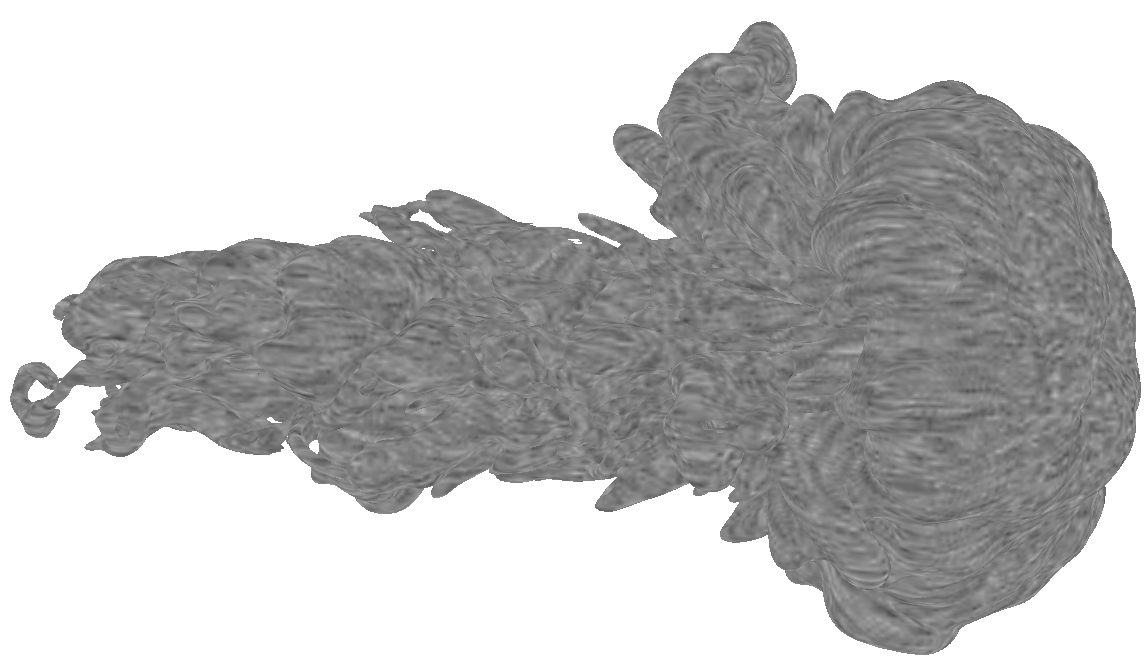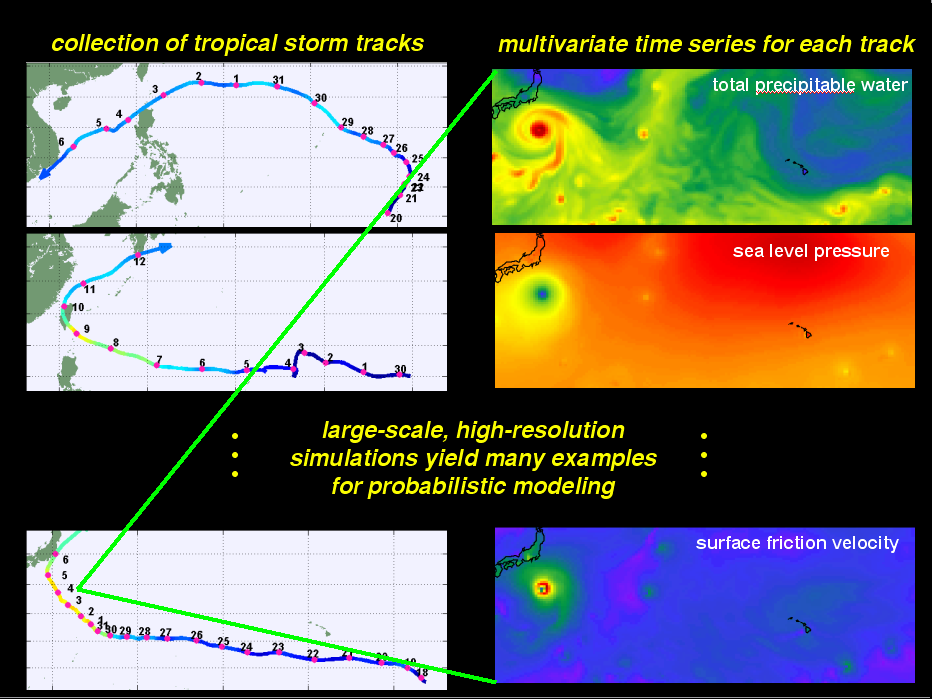This is an archival copy of the Visualization Group's web page 1998 to 2017. For current information, please vist our group's new web page.
Table of Contents
- Feature Detection via Integrated Visualization and Analysis
- Visual Presentation of Features Detected via Topological Analysis
- Latency Tolerant Remote Visualization
- Discovering Relationships Between Variables Using Query-Driven Visualization
- Leadership and Project Management
- Production Quality AMR Visualization
- Supernova Spectrum Synthesis Visual Data Analysis
- 3D Line-Integral Convolution Vector Field Visual Data Exploration
- SUNFALL – Production Analytics Pipeline
- Deep Sky Map – Reference Dataset for the Astrophysical Research Community
- Analysis for Climate and Astrophysics
Base
SciDAC/VACET
NERSC Analytics
Base
- Feature Detection via Integrated Visualization and Analysis – The combination
of visualization and analysis with data management, sometimes referred to as
Visual Analytics, holds great potential to accelerate scientific discovery.
Working closely with researchers in life sciences, our team has pioneered a new approach
for visual knowledge discovery that combines traditional visualization, analysis and visual
data mining to aid in discovering the gene regulation relationships in time-varying
gene expression data. Discovering and displaying such relationships is an important
and scientifically valuable form of feature detection. The research
prototype software, PointCloudXplore, is presently in use by Berkeley Lab Life
Sciences researchers and is being adapted for use in other scientific
domains, e.g., Accelerator and Fusion.
Publications:- G. H. Weber, O. Rübel, M.-Y. Huang, A. H. DePace, C. C. Fowlkes, S. V. E. Kerdnen, C. L. Luengo Hendriks, H. Hagen, D. W. Knowles, J. Malik, M. D. Biggin, and B. Hamann, "Visual Exploration of Three-Dimensional Gene Expression Using Physical Views and Linked Abstract Aiews," Accepted for Publication in IEEE Transactions on Computational Biology and Bioinformatics, 2007. (LBNL publication number pending.)
- O. Rübel, G. H. Weber, S. V. E. Kerdnen, C. C. Fowlkes, C. L. Luengo Hendriks, L. Simirenko, N. Y. Shah, M. B. Eisen, M. D. Biggin, H. Hagen, J. D. Sudar, J. Malik, D. W. Knowles, and B. Hamann, "PointCloudXplore: Visual Analysis of 3D Gene Expression Data Using Physical Views and Parallel Coordinates," in Data Visualization 2006 (Proceedings of EuroVis 2006), B. S. Santos, T. Ertl, and K. Joy, Eds., Aire-la-Ville, Switzerland, 2006, pp. 203-210. LBNL-60005.
- O. Rübel, G. H. Weber, M.-Y. Huang, E. W. Bethel, M. D. Biggin, C. C. Fowlkes, C. L. Luengo Hendriks, Member, IEEE, S. V. E. Kerdnen, M. B. Eisen, D. W. Knowles, J. Malik, H. Hagen, and Bernd Hamann, "Integrating Data Clustering and Visualization for the Analysis of 3D Gene Expression Data ," Submitted to IEEE Transactions on Computational Biology and Bioinformatics, 2007.
- M.-Y. Huang, O. Rübel, G.H. Weber, C.L. Luengo Hendriks, M.D. Biggin, H. Hagen, B. Hamann. "Segmenting Gene Expression Patterns of Early-stage Drosophila Embryos.", In: L. Linsen, H. Hagen, B. Hamann, eds., Mathematical Methods for Visualization in Medicine and Life Sciences. Springer-Verlag, Heidelberg, Germany. 2007. LBNL-62450.
- Visual Presentation of Features Detected via Topological Analysis –
In response to the desire to increase scientific understanding through visual data
analysis of very large and complex datasets, our team has developed a novel technique
for effectively presenting the results of features detected through topological analysis.
Unlike traditional visualization techniques, which are not capable
of presenting a complete view of a function or field, topological analysis
provides a complete study of the variation of a function or field and describes all
its features and their location in space either in terms of critical points or interms
of entire regions. The breakthrough of this new work is a novel presentation technique
that makes abstract topological analysis more visually accessible by using
a familiar landscape presentation metaphor.
Publications:- G. H. Weber, P.-T. Bremer, and V. Pascucci. "Topological Landscapes: A Terrain Metaphor for Scientific Data," Accepted for Publication in IEEE Visualization 2007, Transactions on Visualization and Computer Graphics, 2007. (LBNL publication number pending.)
- Latency Tolerant Remote Visualization –
One of the fundamental problems in remote visualization - where I/O and data intensive visualization activities take place at a centrally located supercomputer center and resulting imagery is delivered to a remotely located user - is reduced interactivity resulting from the combination of high network latency and relatively low network bandwidth. This research project has produced a novel approach for latency-tolerant delivery of visualization and rendering results where client-side frame rate display performance is independent of source dataset size, image size, visualization technique or rendering complexity. As such, it is a suitable solution for remote visualization image delivery for any visualization or rendering application that can generate image frames in an ordered fashion. This new capability is suitable for use in addressing many of ASCR's remote visualization needs, particularly deployment at open computing facilities to provide remote visualization capabilities to teams of scientific researchers.
Publications:- J. Chen, I. Yoon and E. W. Bethel. "Interactive, Internet Delivery of Visualization via Structured, Prerendered Multiresolution Imagery." Accepted for publication, to appear in IEEE Transactions on Visualization and Computer Graphics (2008). LBNL-62252.
- J. Chen, I. Yoon, E. W. Bethel. "Interactive, Internet Delivery of Scientific Visualization via Structured, Prerendered Imagery." In Proceedings of the 2006 SPIE/IS&T Conference on Electronic Imaging, Volume 6061, A 1-10, 2006. LBNL-57528.
- Discovering Relationships Between Variables Using Query-Driven Visualization – One fundamental element of scientific inquiry is discovering relationships, particularly the interactions between different variables in observed or simulated phenomena. Building upon our prior work in the field of Query-Driven Visualization, where visual data analysis processing is focused on subsets of large data deemed to be "scientifically interesting," this new work focuses on a novel knowledge discovery capability suitable for use with petascale class datasets. It enables visual presentation of the presence or absence of relationships (correlations) between variables in data subsets produced by Query-Driven methodologies. This technique is particularly useful for gaining knowledge from datasets currently emerging from SciDAC and INCITE projects. It is sufficiently generally to be applicable to any time of complex, time-varying, multivariate data from structured, unstructured or adaptive grids.
- L. Gosink, J. Anderson, E. W. Bethel, K. Joy. "Variable Interactions in Query-Driven Visualization." IEEE Visualization 2007, Transactions on Visualization and Computer Graphics. (Accepted for publication) LBNL-63254.
Publications:
VACET
- Publications: approximately 20 journal articles in the visualzation and graphics field's premier forums.
- VACET's parallel-capable software infrastructure, which includes features desired by science stakeholders, deployed at NERSC/LBNL and CCS/ORNL for use by a broader science community.
- Active outreach, including a strong presence at the SciDAC 2007 meeting in Boston, contributions to the SciDAC Review magazine and ASCR Discovery website.
- Project website (www.vacet.org) for public consumption and wiki (http://www.sci.utah.edu/vacetwiki/) for internal use.
- Activities coordinated with other SciDAC Centers, Institutes and Science Applications have produced meaningful contributions and measureable positive impact for the SciDAC program as a whole: top quality publications, production-quality visual analysis software infrastructure deployed at DOE's Open Computing facilities, leadership of meaningful and impactful visual data analysis activities in DOE.
Publications:
- G.H. Weber, V. Beckner, H. Childs, T. Ligocki, M. Miller, B. van Straalen, E.W. Bethel. "Visualization Tools for Adaptive Mesh Refinement Data." In: W. Benger, R. Heinzel, W. Kapferer, W. Schoor, M. Tyagi, S. Venkataraman, G.H. Weber, eds., Proceedings of the 4th High End Visualization Workshop (Tyrol Austria, June 18-22, 2007). ISBN 978-3-86541-216-4, Lehmanns Media, pp. 12-25, 2007. LBNL-62954.
NERSC Analytics
- SUNFALL – Production Analytics Pipeline – C. Aragon led a team of scientists in the design, implementation, and deployment of a production data analytics pipeline for the Nearby Supernova Factory project. The project, dubbed SUNFALL (SuperNova Factory Assembly Line), incorporates sophisticated astrophysics image processing algorithms, machine learning capabilities including boosted trees and support vector machines, and astronomical data analysis with a usable, highly interactive visual interface designed to facilitate collaborative decision making. The new software system has resulted in a dramatic improvement in scientific productivity with an estimated 85-90% savings in effort spent analyzing supernova target images and a 75% reduction in time spent classifying the target images due to an improved visual data mining interface. In addition, SUNFALL has automated the data migration and management tasks that were formerly performed manually through an automatic and fault-tolerant transfer and archival of data between remote locations, NERSC HPSS, and local user workstations.
- Deep Sky Map – Reference Dataset for the Astrophysical Research Community. One of the team members, having extensive experience in astrophysics imaging, linear algebra and parallel processing created a ``Deep Sky Map'' from observations taken via the Palomar-QUEST Consortium, the Nearby Supernova Factory and the Near Earth Asteroid team. The resulting map that covers 20,000 square degrees of sky, is about 60TB in size, and provides a temporal and static catalog of astrophysical objects. This work has attracted the attention of several groups and promises to be a useful reference dataset for the entire astropysical community. This test dataset has allowed some NERSC users to improve their processing by a measureable amount by consolidating data I/O and search operations. More information.
- Analysis for Climate and Astrophysics – the Team designed, implemented and where appropriate, put
into production new data analysis capabilities targeting specific science
applications. These include: tools for tropical storm formation and path
tracking; tools for spectrum synthesis analysis using support vector
machines for the purpose of classification; tools using several different
techiques for supernovae target recogniction in a large, multidimensional
data space consisting primarily of optical images. These works resulted in
many publications:
- S. Bailey, C. Aragon, R. Romano, R. C. Thomas, B. A. Weaver and D. Wong. "How to Find More Supernovae with Less Work: Object Classification Techniques for Difference Imaging." Astrophysical Journal (accepted for publication 2007). LBNL-62659.
- C. Aragon and D. Aragon. "A Fast Contour Descriptor Algorithm for Supernova Image Classification." In Proceedings of the SPIE/IS&T Conference on Electronic Imaging, Volume 6469-07, Nasser Kehtarnavaz, Matthias F. Carlsohn, eds. January 2007. LBNL-61182
- Bailey, S.; Aldering, G.; Aragon, C.; Bongard, S.; Childress, M.; Loken, S.; Nugent, P.; Perlmutter, S.; Runge, K.; Scalzo, R.; Romano, R.; Thomas, R.; Weaver, B.; Baltay, C.; Bauer, A.; Herrera, D.; Rabinowitz, D.; Pecontal, E.; Rigaudier, G.; Antilogus, P.; Gilles, S.; Pain, R.; Pereira, R.; Buton, C.; Copin, Y. "How to Find More Supernovae with Less Work: Object Classification Techniques for Difference Imaging." Poster at 2007 AAS/AAPT Joint Meeting, American Astronomical Society Meeting 209, #78.09. December 2006 (Poster)
- R. Romano, C. Aragon and C. Ding. "Supernova Recognition Using Support Vector Machines." Proceedings of the 5th International Conference on Machine Learning and Applications (ICMLA'06), Orlando, FL, December 2006. LBNL-61192. (Best Paper Award!)

|
| This image is a subset of the complete Deep Sky map showing the Coma cluster. To create this subset, over 500 images collected during the period 2001-2007 were combined. |
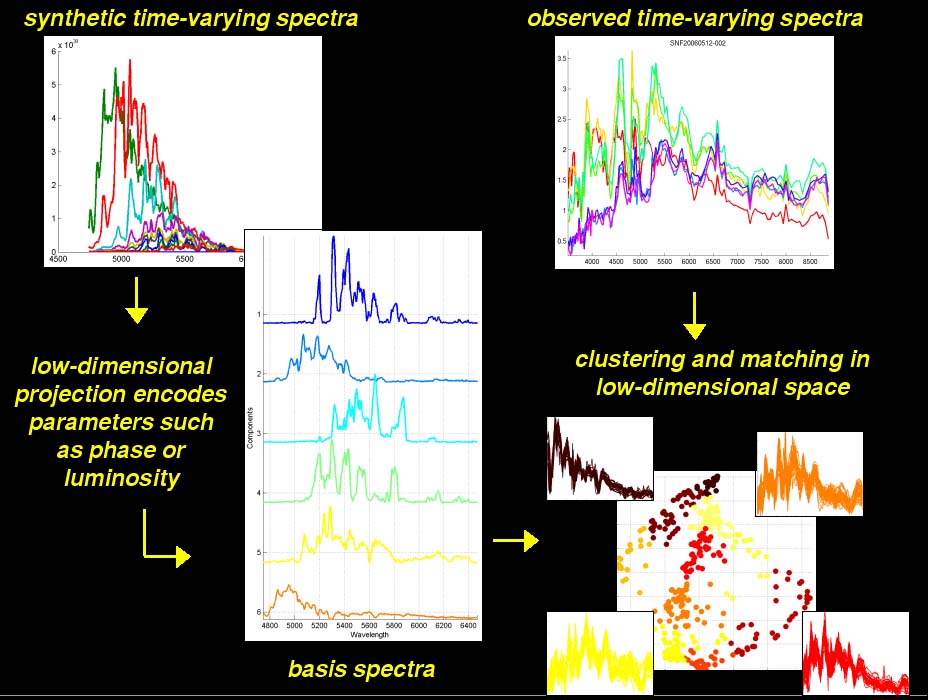
|
| Statistical machine learning techniques enable automatic spectra classification. This capability helps eliminate manual classification steps and increases scientific insight. |

